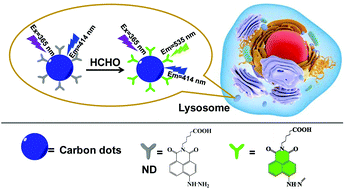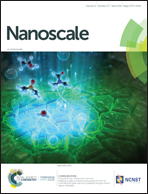A ratiometric fluorescent nanoprobe based on naphthalimide derivative-functionalized carbon dots for imaging lysosomal formaldehyde in HeLa cells†
Abstract
Endogenous formaldehyde (FA) exists in many living cells and in inhomogeneous distribution in organelles. In particular, lysosomes play significant roles in FA generation and the biofunction of living cells. Herein, we developed a new ratiometric fluorescent nanoprobe, based on naphthalimide derivative (ND)-functionalized carbon dots (CDs), for monitoring endogenous FA in lysosomes. The fluorescence intensity (F535) of green-emitting ND at 535 nm serves as the response signal and the fluorescence intensity (F414) of blue-emitting CDs at 414 nm acts as the reference signal. The fluorescence intensity ratio (F535/F414) of the CD-ND probe is linearly correlated with FA concentration within the range of 1–40 μM in aqueous solution, and the detection limit (3σ/slope) is estimated to be 0.34 μM. As for practical application, this nanoprobe is utilized for the ratiometric fluorescence imaging of FA in live cells. Remarkably, this nanoprobe can specifically target and stain the lysosomes and detect exogenous and endogenous FA in HeLa cells. The new FA probe shows a superior lysosomal targeting ability with a Pearson's coefficient of 0.93, which is attributed to the macromolecular size and basic amine group functionalized surface of CD-ND.



 Please wait while we load your content...
Please wait while we load your content...